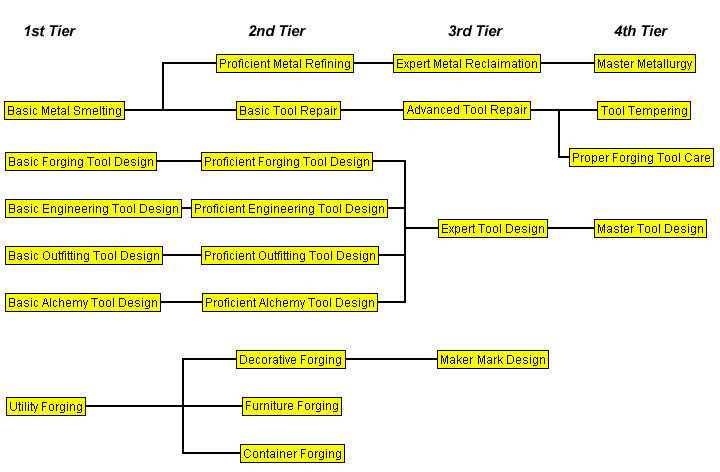Blacksmithing techniques
(Redirected from Blacksmithing Techniques)
Jump to navigation
Jump to search
Techniques for the Blacksmithing discipline.
See Craft for more information on what you know/can learn.

Smelting & Repair
Technique Description Basic Metal Smelting The concepts of Basic Metal Smelting reduce the difficulty of mixing metals in the crucible. Proficient Metal Refining Learning Proficient Metal Refining will reduce material losses sustained in the refining process (from 50% to 20%). Expert Metal Reclamation The technique of Expert Metal Reclamation shall increase yields from smelting down forged goods. Master Metallurgy As a Master of Metallurgy, you work around metal impurities and produce higher quality products as a result. This portion likely only works with blacksmithing products. This technique also lets you see the metal composition of ingots and forged items such as tools, weapons and armor given enough skill. To do so, simply hold the ingot/item and analyze it and you'll get a description back like:
The metal appears to be composed of: 2.25% brass, 75.24% bronze, 3.98% high carbon steel, 0.04% oravir, 0.10% gold, 0.00% lead, 6.12% medium carbon steel, and 12.23% silver.
Basic Tool Repair Those trained in Basic Tool Repair will find a substantial increase to the amount by which they can repair items. Advanced Tool Repair Advanced Tool repair vastly reduces the time needed to repair damaged tools. It also allows repair of badly damaged tools. Tool Tempering Applying the technique of Tool Tempering allows the blacksmith to increase the durability of previously forged tools. This technique is required to temper tools.
Proper Forging Tool Care Proper Forging Tool Care teaches the blacksmith how to guard a tool against premature wear. Knowledge of this technique will reduce chance for tools taking damage, and totally prevent damage on newly repaired tools for several anlaen of use (two hours of logged in time).
Tool Design
Technique Description Basic Forging Tool Design Tools commonly used in the Forge can be created with ease once you know the Basic Forging Design principles. Proficient Forging Tool Design The Proficient Forging Design makes the process of forging secondary tools used in the forging process much easier. Basic Engineering Tool Design Basic Engineering Design principles will markedly increase your skill with forging these basic tools. Proficient Engineering Tool Design Knowledge of the Proficient Engineering Design technique further enhances your ability to forge more exotic engineering tools. Basic Outfitting Tool Design By learning the Basic Outfitting Design technique, your skill with forging the common outfitting tools is augmented. Proficient Outfitting Tool Design The harder and more complicated outfitting tools are made easier when you know about Proficient Outfitting Design. Basic Alchemy Tool Design Common Alchemy tools become easier to forge with training in Basic Alchemy Design. Proficient Alchemy Tool Design Forging harder and more complicated Alchemy tools become a snap when you understand Proficient Alchemy Design techniques. Expert Tool Design Requires all basic and proficient tool design techniques. Some rare tools can be used across two disciplines, and those designs are made easier when you know about Expert Tool Design.
Master Tool Design Exotic tools that double as weapons, or that can perform across multiple disciplines are taught with Master Tool Design.
Utility Forging
Technique Description Utility Forging Forged goods that serve a wide range of utility purposes are made easier by knowing the Utility Forging technique. Decorative Forging Designing worn forged goods becomes easier when taught the Decorative Forging technique. Furniture Forging Learning the Furniture Forging technique improves your ability with making items for the home. Container Forging Advanced knowledge of forging containers will bonus your ability to make them. Maker Mark Design The technique allows the creation of maker's marks for marking crafted items. This technique is required to forge a maker's mark.